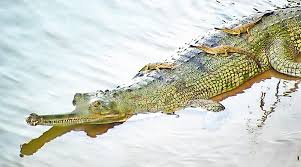PRELIMS BITS

Context: Scientists have recently issued a warning that the Indian gharial, along with five other species, could face extinction within the next five years unless urgent conservation efforts are implemented.
About Indian Gharial
- Scientific Name: Gavialis gangeticus
- Common Names: Gharial, Fish-Eating Crocodile, Indian Gavial, Long-Nosed Crocodile
- Unique Feature: It is the only crocodilian species that exhibits visible sexual dimorphism, named after the “Ghara” (pot-like structure) on males’ snouts.
Habitat & Distribution
- Preferred Habitat: Deep, clear, fast-flowing rivers with steep, sandy banks.
- Geographical Range: Found only in India and Nepal, with the remaining wild population concentrated in the Ganges River system.
- Current Population: Less than 250 individuals survive in the wild.
Morphology & Characteristics
- Skin: Thick, smooth scales that do not overlap.
- Snout: The thinnest and most elongated among all crocodilians, reducing resistance in water.
- Feeding Mechanism: The narrow snout allows swift lateral movements, enabling quick capture of fish.
Diet
- Primarily fish eaters.
- Occasionally scavenge on dead animals.
- Also feed on insects, larvae, small frogs, and warm-blooded species.
Major Threats
- Dam construction – Alters river flow and disrupts habitat.
- Water abstraction & barrages – Reduces water levels in key habitats.
- Riverbed cultivation – Leads to habitat destruction.
- Pollution – Degrades water quality and impacts food availability.
- Loss of natural river ecosystems – Further limits suitable breeding grounds.
Conservation Status
- IUCN: Critically Endangered
- CITES: Appendix I
- Wildlife (Protection) Act, 1972: Schedule I




